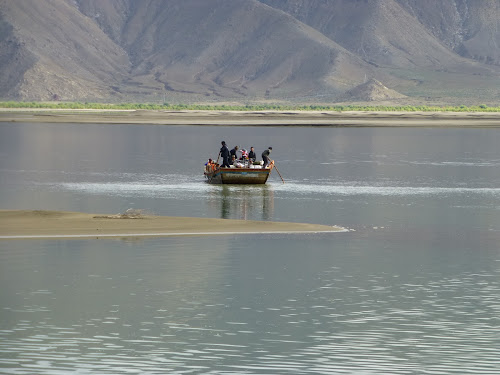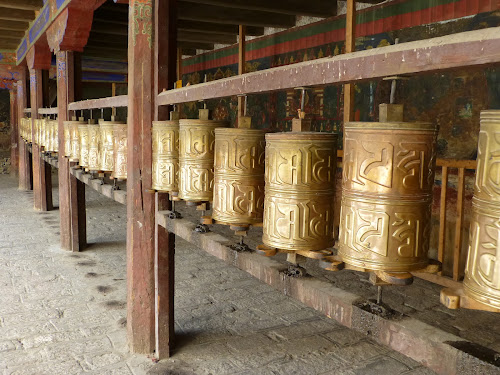This morning we left Tsedang for the day to visit the Samye Monastery. To get there, we drove by bus for about an hour to a ferry landing, from there we took a ferry across the Tsongpo River and then drove a short distance to the monastery. We want to introduce you to the young gentleman who has driven us around Lhasa and to Tsedang on his bus...this is Tile (we think that this is how it is spelled...pronounced Tee-lay...we were initially told his name was Chile, like the country, but when he found out we were calling him Chile he explained to us that Chile in Tibetan language means kidnapped...oops...). Tile was always animated and smiling, and he loved to drive fast...!
It seems that the Chinese put up security checkpoints everywhere, and in our travels through Tibet we stop at countless checkpoints...
Where we're from, the word "ferry" conjures up images of large, double-ended steel vessels with multiple decks for carrying hundreds of vehicles, and a passenger deck to accommodate passengers during the ferry crossing. We knew we were in for a new definition of "ferry" when we pulled up to the landing...no Starbucks or McDonalds here...
And these are the ferry boats...a little different than what we're used to...flat bottom, wood boats with a small tractor engine on the back attached to a drive shaft and propeller. And there is no wifi available either..
The day is calm and sunny, so it is a magnificent day for a boat ride...these photos give you a sense of the ferry boat, the passengers, and the views as we crossed the Tsongpo River...we are treated to breathtaking views of the mountains as well as wildlife like the Bar-headed Goose and the Brahmani Duck...
Now, the Tsongpo River is wide and in most places not very deep. It appears that the current is constantly shifting and shaping the sand bars, so our river pilot took a very circuitous route to the opposite bank. At a few places we felt the boat give a small shudder or slow suddenly as the bottom of our ferry rubbed across the bottom of the river...we look at our guide Nyima...not really very comforting to see that she has her prayer book in hand...then she grabs a pilgrim's baby and starts teaching her how to pray...!
Thankfully, we cross without incident and soon the ferry terminal...er, beaching spot, is in sight.
We are met by a driver with a minivan...and I do mean "mini", but our group has grown close anyway, so this is right up our alley. We sat in the rear seat with Ted and enjoyed a very exciting ride on the bumpy road to the monastery.
When we arrive at Samye monastery, we immediately notice that there are very long lines of prayer wheels stretching off in both directions. This monastery has 1,000 prayer wheels...
We are also greeted by the sight and sounds of Tibetans repairing the roof of the monastery, like we saw at the Traduk Monastery the day before, but this time there seemed to be nearly a hundred of these workers singing as they tamped the concrete on the roof...
The Samye Monastery is beautiful, and it is also the first monastery built in Tibet, dating back to the 8th century. The monastery was built by the king of Tibet with assistance from the leader of the Red Hat sect of Tibetan buddhists, and is known for the beautiful and detailed murals on its walls that depict Tibetan history. The monastery is laid out so that it reflects the Buddhist perspective of the universe, and it is encircled by stupas to protect against evil...here are some of the stupas which are several stories tall...
Our guide Nyima is helping us to learn about and recognize the various gods we see in so many of these monasteries. This is the god of compassion which is always depicted with 1,000 hands and 1,000 eyes (an eye on each hand). In our opinion, eyes on the hands is not a good design..not when you use Purell frequently...really makes the eyes water...!
What we were not able to get photos of, but which was amazing, was an unlit interior corridor that encircled the main chapel in the monastery. Steve and Michael illuminated the passageway with headlamps, and we could see that the three foot wide corridor stretched two or three stories high and both walls were painted with murals all the way to the ceiling. We made our way through the dark corridor and emerged around the other side of the main chapel.
The Samye monastery is a popular stop on Tibetan Buddhists' pilgrimages, and we see prayer flags left by pilgrims on the hill adjacent to the monastery that is topped by a meditation hut. We also get some great views from the upper level of the monastery...
These are photos of the monastery storehouse and the monks quarters...
Prayer wheels are everywhere...we did not conduct a complete counting, but we believe there are at least 1,000 of them here...
Here's a figure that has such a bad connotation today, but many centuries ago this was a symbol of good fortune...this is carved into the doorsill at the entrance to the monastery...
Here's a small tangent, but an important one. We showed you the Asian toilet from the Seoul airport, and that is something that we were familiar with. The Tibetan toilet, however, is a different thing altogether, and we present this short tutorial as a public service to all of you future travelers to Tibet. What is pictured below is the kind of toilet set up we have come across nearly everywhere. It consists of divider walls about three and a half feet high, and the toilet is a slot in the floor that is about six inches wide and runs the width of the stall. Flushing is something that you do not control, and, quite frankly, our experience leads us to believe that flushing is not a frequent occurrence. You can take it from here in terms of how to approach the slot...but don't say we did't warn you...
After taking in all that Samye Monastery had to offer, we meet our friend Tile again and we begin the drive downriver on the opposite side of the river from Tsedang. Along the way we stop for a picnic lunch, pretty much in the middle of nowhere, but we found a spot with shade next to a small creek. Tile even pulled the seat cushions out of the bus and we used them to sit on while we ate...he's so thoughtful...What's interesting about the area around Tsedang along the river is that the terrain turns quite sandy, and we see sand dunes, some quite large and tall, as we drive back to Tsedang. We also catch glimpses of the snow-capped mountains rising up over the mustard fields...
The roads here have improved dramatically, according to Steve, so the long days of dusty driving are now much fewer...the asphalt out here looks pretty new!
On our way back to Tsedang we drive up switchbacks to the top of a pass, and we stop there for some photos. The roadway passes between two raised shoulders, and over time people have strung prayer flags across the road...it is really quite a sight as the flags flap in the winds that climb up to the top of the pass from the valley below...
We continue on along the river without incident...well, Dick did ask our driver to stop suddenly so he could hop out and take a picture of a bush...turned out to be something other than what he thought...
Soon we're back to the city, and back to the orderly flow of traffic...are those buses in the cycle lane?...and pedicabs in the car lane...?
As has become the routine with this fun group of travelers, we meet in the hotel bar for our own "happy hour" to share photos and unwind a little. This evening, the topic of conversation is the news that China has closed Tibet to all tourists. We have been very aware of the rising tension in Tibet since the Sunday before our tour started, when two young monks lit themselves on fire in protest outside the Johkang in Lhasa. This prompted China to send large numbers of soldiers into Tibet, particularly Lhasa, and we saw the gradual tightening of security when we were there...metal detectors at the square in front of the Johkang Temple, the requirement that we be accompanied by a guide when out shopping in Lhasa, and the early shutdown of the Barkhor market on the Monday holiday when so many pilgrims were in Lhasa. We also learned while in Lhasa that China stopped granting any new permits for travelers to visit Tibet, and this ban would perhaps stretch into July. Today's news, however, raised all sorts of questions...would we be allowed to complete our tour? Would this possibly lead to a decision by the Chinese government to expel all foreigners from Tibet, including our group? How long would it take us to drive to the border if directed to do so? Our tour agency is keeping an eye on the situation as it unfolds, and we will just keep spinning the prayer wheels and hoping for the best. With each passing day we get closer to completing our journey through Tibet...
Dinner together is another opportunity to share our reflections on the day's experiences, to laugh, to get Ted's Tip of the day (more to come on this later) and to ask "what kind of meat is that?" as dishes pass us by on the lazy susan...
Now, we've talked about yak a fair amount, the many uses made of this animal, and its centrality to Tibetan survival. We also fully appreciate the resourcefulness of the Tibetan people who use every bit of this magnificent animal so as to be respectful and not waste a thing. However, we think that we can all agree there should be some boundaries, and the case for such boundaries is made obvious by this menu item offered at our hotel's restaurant...
Enough said...
This wraps up our time in Tsedang, and tomorrow we will leave for Gyantse and the continuation of this great adventure.
















































I'm so glad you are back on line. I love reading the blog and it is also my way of knowing you two are ok. Keep it coming!
ReplyDeleteThanks Beck!! Glad you are enjoying it...and we will see you soon!!
ReplyDeleteThanks Nancy, and thanks for following along!
ReplyDelete